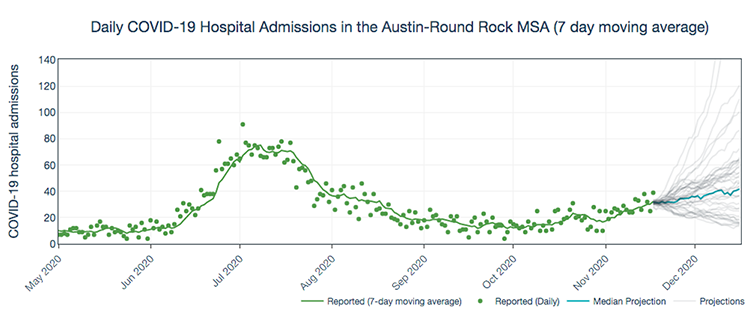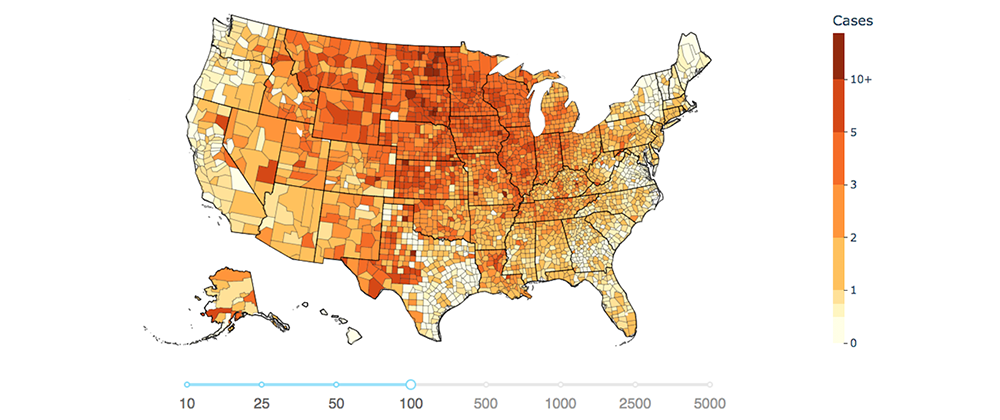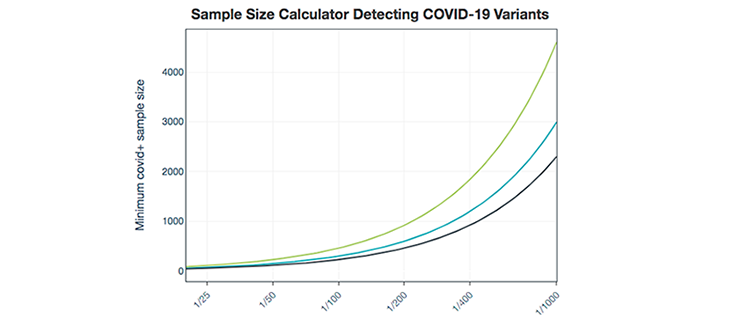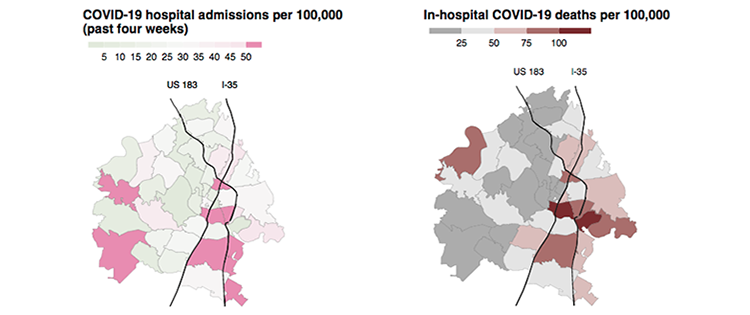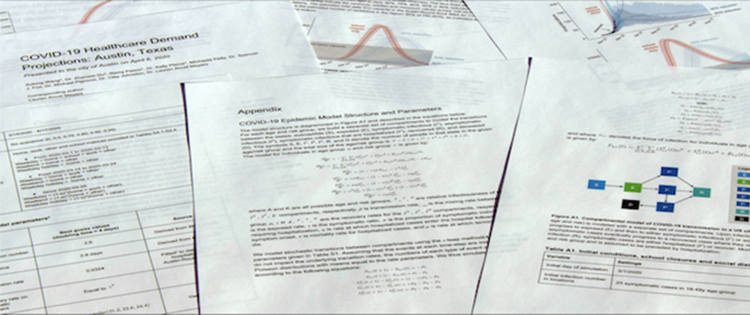UT Austin COVID-19 Modeling Consortium
An interdisciplinary network of researchers and health professionals building models to detect, project, and combat COVID-19
The UT COVID-19 Modeling Consortium unites scientists, social scientists, and engineers in developing innovative models that advance the surveillance, forecasting and mitigation of this unprecedented and elusive threat. Led by Professor Lauren Ancel Meyers, the consortium is actively supporting community workers and health professionals on the front line of the fight against COVID-19 and providing decision-support analyses for local, state and national leaders striving to protect the health and well-being of our society.
To learn more about UT COVID-19 Modeling Consortium models and research please visit our Publications and Projections webpages.
COVID-19 Modeling Consortium News
National Science Foundation Award Paves Way for UT Center for Pandemic Decision Science
The National Science Foundation has selected The University of Texas at Austin for a pilot grant to establish the UT Center for Pandemic Decision Science (CPDS). The new interdisciplinary center will bring together scientists, engineers, clinicians and policymakers to tackle the grand challenge of preparing the world to combat future pandemic threats.
“This represents an ambitious next step for the UT COVID-19 Modeling Consortium,” said Lauren Ancel Meyers, a professor of integrative biology and statistics and data sciences who is directing the effort. “Over the last three years, the consortium has been a leading force in pandemic forecasting to help individuals, schools, communities and global leaders navigate the changing risks of the virus.” LEARN MORE
Delays in Contact Tracing Impeded Early COVID-19 Containment
Contact tracing programs were deployed around the globe to slow the spread of COVID-19, but these programs could not prevent the multiple waves of transmission and loss of life that have occurred since March 2020. In a new study published in the Proceedings of the National Academy of Sciences, researchers at The University of Texas at Austin found that a five-day delay between identifying a case and isolating contacts was the Achilles’ heel of a contact tracing program in a large U.S. city. LEARN MORE
COVID Forecasting Method Using Hospital and Cellphone Data Proves It Can Reliably Guide US Cities Through Pandemic Threats
Using cellphone mobility data and COVID-19 hospital admissions data, researchers at The University of Texas at Austin have reliably forecast regional hospital demands for almost two years, according to a new study published in the Proceedings of the National Academy of Sciences. The forecasting system, which municipal authorities credit with helping Austin maintain the lowest COVID-19 death rate among all large Texas cities, has been built out for use by 22 municipal areas in Texas and can be used by any city to guide COVID-19 responses as the virus continues to spread. LEARN MORE
Austin's east side shoulders greater COVID-19 burden and has lower vaccination rates
Researchers at the University of Texas at Austin's COVID-19 Modeling Consortium have just completed an interactive dashboard that estimates the spatial distribution of SARS-CoV-2 infections and vaccine administration across Austin, TX. The dashboard updates with new data daily. Researchers found marked geographic differences in these outcomes. In particular, ZIP codes on the city's western side tend to have higher vaccine coverage than ZIP codes on the city's eastern side. These differences mirror disparities in social vulnerability, as measured by the CDC's social vulnerability index (SVI), which tends to be higher in eastern ZIP codes than in western ZIP codes. LEARN MORE
Rental Eviction and the COVID-19 Pandemic: Averting a Looming Crisis
The National Academies of Sciences, Engineering, and Medicine panel has developed actionable guidance recommendations for the Executive Office of the President of the United States on how to ensure that renters can stay in their homes and housing aid reaches the communities that need it most. A federal moratorium on rental eviction is set to expire on July 31st, 2021. UT Covid-19 Modeling Consortium director Lauren Ancel Meyers served on the panel that created Rental Eviction and the COVID-19 Pandemic: Averting a Looming Crisis. The report recommends actions to be taken both urgently and over the next three years aimed at addressing the immediate crisis as well as long-standing needs related to housing choice, affordability, and security across the United States. These include building on existing social programs that support those struggling with poverty and housing instability; efficiently channeling emergency relief to renters and landlords; increasing the availability of housing choice vouchers; reforming unemployment insurance; and reducing discriminatory practices and systemic inequities. LEARN MORE
System Linked to Operational Hospitals, Shorter Lockdowns, Lives Saved
A staged alert system, designed by scientists and public health officials to guide local policies, helped one city prevent hospital surges and long lockdowns, according to new research published in the journal Nature Communications.
In this study, led by The University of Texas at Austin COVID-19 Modeling Consortium in collaboration with Northwestern University, researchers describe the system that has guided COVID-19 policies in Austin, Texas, for more than a year, helping to safeguard the health care system and avoid costly measures. It tracks the number of new daily COVID-19 hospital admissions and triggers changes in guidance when admissions cross specific threshold values. While using this staged alert system, the Austin metropolitan area has sustained the lowest per capita COVID-19 death rate among all large Texas cities. . LEARN MORE
Forecasting Resources Needed to Protect People Experiencing Homelessness During COVID-19
Based on the level of infection in Austin, a new study offers public health authorities with a method of calculating the number of COVID-19 isolation beds needed for people experiencing homelessness. The research holds promise for controlling spread of the virus – or future infectious diseases – in a population that is highly vulnerable and less likely than many others to access health care services. The paper’s first author is an undergraduate student at UT Austin, Tanvi Ingle, who harnessed her days in the pandemic lockdown to work with researchers in UT Austin COVID-19 Modeling Consortium. LEARN MORE
Vaccination rates, Healthcare Demand and SARS-CoV-2 Mortality Look-Back Shows Geographic Differences in Austin
Geographic differences in the estimated spatial distribution of SARS-CoV-2 infections and vaccine administration across Austin, TX were discovered by the researchers at UT Austin’s COVID-19 Modeling Consortium. In particular, ZIP codes on the western side of the city tend to have higher vaccine coverage and lower estimated cumulative infections than ZIP codes on the eastern side of the city. These differences mirror disparities in social vulnerability, as measured by the CDC’s social vulnerability index (SVI), which tends to be higher in eastern ZIP codes than in western ZIP codes. LEARN MORE
Consortium Awarded Rockefeller Foundation Covid-19 Modeling Accelerator Grant to Extend COVID-19 Dashboard to Inform Local Decision-making throughout the United States
The team at UT Austin will extend the Texas COVID-19 Dashboard to provide weekly forecasts of COVID-19 hospitalizations and ICU patients for every county in the US using a validated model of COVID-19 transmission dynamics driven by local hospitalization and cellphone mobility data. It will include interactive visualizations of past hospital and ICU census data, one-month ahead healthcare forecasts, and the past and current transmission rate of the virus for all counties, metros, states and the entire U.S. This tool will facilitate real-time risk assessments by policymakers, public health agencies, schools and the public, and provide vital projections to inform timely countermeasures and ensure sufficient ICU and hospital capacity. Lauren Ancel Meyers of The University of Texas at Austin and Michael Lachmann of the Santa Fe Institute will lead the team’s work on the project . LEARN MORE
New Report Shows Potential Impact of Holiday Gatherings on COVID-19 Hospitalizations in Austin
To support public health decision-making and healthcare planning, the UT Austin COVID-19 Modeling Consortium developed a model for the five-county Austin-Round Rock Metropolitan Statistical Area (henceforth Austin) that can provide real-time estimates of the prevalence and transmission rate of COVID-19 and project healthcare needs into the future. In this report, COVID-19 hospitalization data for Austin from March 13 to December 19, 2020 is used to estimate the state of the pandemic in late December and project hospitalizations through mid-January of 2021, under three hypothetical scenarios for the impact of winter holiday gatherings on the transmission of COVID-19 in Austin. LEARN MORE
New Dashboard Helps Parents and Educators Estimate COVID-19 Risks in Schools
With COVID-19 cases hitting new highs across the country, families wondering how risky it is to send their kids to school in person and school leaders planning for the future can use a new interactive dashboard from the University of Texas at Austin COVID-19 Modeling Consortium to learn more about the risks. The tool estimates how many infected people are likely to show up at school on a given day anywhere in the United States. LEARN MORE
UT Undergraduate Students Provide Invaluable Support for COVID-19 Research
As the COVID-19 pandemic continues, UT undergraduate students have continued to rise to the challenge in many ways, including research. Several undergraduates were already supporting the Meyers Lab, which has expanded into the UT COVID-19 Modeling Consortium. The Consortium also held a Research Showcase where hundreds more showed interest in joining the research efforts. Most recently three researchers from the Consortium hosted a Science Sprint where over 30 undergrads tackled research questions. Undergrads continue to be vital to the planning and mitigation of this pandemic, from their work ethic to their passion for making a difference in the world. LEARN MORE
Curbing COVID-19 Hospitalizations Requires Attention to Construction Workers
Construction workers have a much higher risk of becoming hospitalized with the novel coronavirus than non-construction workers, according to a new study from researchers with The University of Texas at Austin COVID-19 Modeling Consortium. LEARN MORE
New Report Projects Increasing Coronavirus Hospitalizations in Texas
The University of Texas at Austin COVID-19 Modeling Consortium has released a report forecasting COVID-19 hospitalizations and ICU patients for all 22 Texas Trauma Service Areas (TSAs) for the next three weeks. The projections indicate that pandemic risks are increasing across Texas. Six regions have at least a 25% chance of exceeding hospital capacity in the next three weeks and thirteen regions at least a 25% chance of exceeding ICU capacity, unless policies, behaviors, or healthcare capacities change. areas. LEARN MORE
UT Epidemiologists Launch New Dashboards to Track COVID-19 Across Texas Communities
The University of Texas at Austin COVID-19 Modeling Consortium has launched a new online dashboard to track the spread and impact of the virus, including in hospitals across the state of Texas with detailed information for 22 different areas. LEARN MORE
Early Spread of COVID-19 Appears Far Greater Than Initially Reported
In a new paper in The Lancet’s open-access journal EClinicalMedicine, epidemiological researchers from The University of Texas at Austin estimated COVID-19 to be far more widespread in Wuhan, China, and Seattle, Washington, weeks ahead of lockdown measures in each city. LEARN MORE
The Risk That Students Could Arrive at School With the Coronavirus
The University of Texas COVID-19 Modeling Consortium offers educators and parents a new framework that uses community prevalence of COVID-19 to determine the risks of the virus being introduced in any school. The framework, published in a new interactive from The New York Times, was shared in a report delivered to Texas decision makers and cited in a report on school reopenings from the National Academies of Sciences, Engineering and Medicine. It helps leaders walk through a process of determining priorities, reviewing mitigation strategies and monitoring data with clear guideposts for assessing the risk is at any given time that a student will show up to school infected. LEARN MORE
New Tool to Guide Decisions on Social Distancing Uses Hospital Data and Emphasizes Protecting the Vulnerable
Researchers from the University of Texas at Austin and colleagues have developed epidemiological models that project the spread of COVID-19 and found that school closures in the spring, in and of themselves, only slightly flattened the pandemic curve. Early implementation of strict social-distancing measures, such as shelter-in-place orders, were critical to slowing spread and preventing overwhelming surges in COVID-19 hospitalizations, the researchers explain in a new paper in the journal Emerging Infectious Disease. The team’s models predict how the timing and effectiveness of social distancing impact the spread of COVID-19 and the resulting levels of hospitalizations, patients in intensive care, ventilator needs and deaths for the Austin, Texas area. LEARN MORE
New Dashboard Projects COVID-19 Infections and Hospitalizations in Austin Metro Area
The University of Texas COVID-19 Modeling Consortium has developed a new model that tracks the transmission of COVID-19 in the Austin Metro Area and projects the future of COVID-19 healthcare needs. They are making the model predictions available through the new Austin COVID-19 Dashboard in an effort to help decision makers and citizens to gain basic insight into the rapidly changing risks of COVID-10 and to anticipate surges in healthcare demand. The dashboard provides daily estimates for the rate of COVID-19 spread and projects imminent increases or decreases in COVID-19 hospitalizations and ICU patients. The model incorporates epidemiological characteristics of the disease, demographic information for the Austin area, and mobility data from anonymous cell phone tracing. It can be easily adapted to track the pandemic in other communities based on local COVID-19 hospital admissions data. LEARN MORE
Hoping for a COVID-19 antiviral that limits virus spread
As the COVID-19 pandemic claims hundreds of thousands of lives and wreaks economic havoc worldwide, scientists are racing to develop antivirals that reduce the fatality of the disease. LEARN MORE
COVID-19 Drug Development Could Benefit from Approach Used Against Flu
A new study from researchers at The University of Texas at Austin has found that some antivirals are useful for more than helping sick people get better — they also can prevent thousands of deaths and hundreds of thousands of virus cases if used in the early stages of infection. LEARN MORE
For Each Day’s Delay in Social Distancing, a COVID-19 Outbreak Lasts Days Longer
A new analysis of COVID-19 outbreaks in 58 cities has found that places that took longer to begin implementing social distancing measures spent more time with the virus rapidly spreading than others that acted more quickly. LEARN MORE
Updated: New Model Forecasts When States, Cities Likely to See Peak in COVID-19 Deaths
Researchers at The University of Texas at Austin have released a model that projects COVID-19 deaths for all 50 U.S. states using geolocation data from cellphones to determine the impact of social distancing within each state is showing it may be weeks until deaths peak for many states and metropolitan areas. LEARN MORE
New Model Forecasts 9 States Likely to See Peak in COVID-19 Deaths by End of April
Researchers at The University of Texas at Austin have released a model that provides a daily estimate of fatalities from COVID-19 in the United States for the coming weeks LEARN MORE
Pandemic Model Shows Importance of Social Distancing in 22 Texas Cities
A new pandemic model of COVID-19 shows the positive role social distancing can play in preventing the spread of the illness in areas across the state. LEARN MORE
Coronavirus Spreads Quickly and Sometimes Before People Have Symptoms, Study Finds
Infectious disease researchers at The University of Texas at Austin studying the novel coronavirus were able to identify how quickly the virus can spread, a factor that may help public health officials in their efforts at containment. LEARN MORE
Researchers Say Spread of Coronavirus Extends Far Beyond China’s Quarantine Zone
Infectious disease researchers at The University of Texas at Austin and other institutions in Hong Kong, mainland China and France have concluded there is a high probability that the deadly Wuhan coronavirus spread beyond Wuhan and other quarantined cities before Chinese officials were able to put a quarantine in place. LEARN MORE
